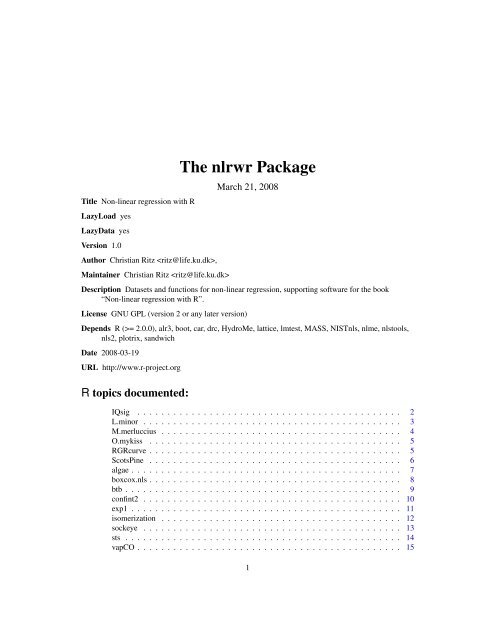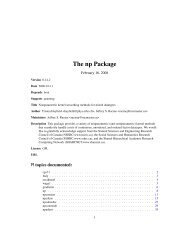The nlrwr Package - NexTag Supports Open Source Initiatives
The nlrwr Package - NexTag Supports Open Source Initiatives
The nlrwr Package - NexTag Supports Open Source Initiatives
You also want an ePaper? Increase the reach of your titles
YUMPU automatically turns print PDFs into web optimized ePapers that Google loves.
O.mykiss 5O.mykissTest data from a 21 day fish testDescriptionTest data from a 21 day fish test following the guidelines OECD GL204, using the test organismOncorhynchus mykiss.Usagedata(O.mykiss)FormatA data frame with 70 observations on the following 2 variables.conc a numeric vector of concentrations (mg/l)weight a numeric vector of wet weights (g)DetailsWeights are measured after 28 days.<strong>Source</strong>Organisation for Economic Co-operation and Development (OECD) (2006) CURRENT APPROACHESIN THE STATISTICAL ANALYSIS OF ECOTOXICITY DATA: A GUIDANCE TO APPLICATION -ANNEXES, Paris (p. 65).ExamplesO.mykissRGRcurveRelative growth ratesDescriptionRelative growth ratesUsagedata(RGRcurve)
6 ScotsPineFormatA data frame with 41 observations on the following 2 variables.Day a numeric vector denoting the number of days elapsedRGR a numeric vector of relative growth ratesDetailsData stem from a large experiment on the effect of herbicides on aquatic plants.<strong>Source</strong>Cedergreen, N. and Andersen, L. and Olesen, C. F. and Spliid, H. H. and Streibig, J. C. (2005)Does the effect of herbicide pulse exposure on aquatic plants depend on K-ow or mode of action?,Aquatic Toxicology, 72, 261–271.ExamplesRGRcurveScotsPineLeaf area index for Scots Pine treesDescriptionLeaf area indices were calculated for Scots Pine trees in a region of Estonia.Usagedata(ScotsPine)FormatA data frame with 14 observations on the following 2 variables.age a numeric vector containing age of pine treeslai a numeric vector containing the leaf area indices<strong>Source</strong>Piegorsch, W. W. and Bailer, A. J. (2005) Analyzing Environmental Data, Chichester: John Wiley& Sons (p. 93).
algae 7Examples## Plotting dataplot(lai~age, data=ScotsPine, xlab = "Age (years)", ylab = "Leaf area index" )## Fitting the mono-exponenetial modelexpFct
8 boxcox.nlsboxcox.nlsTransform-both-sides Box-Cox transformationDescriptionFinds the optimal Box-Cox transformation for non-linear regression models.Usageboxcox.nls(object, lambda = seq(-2, 2, 1/10), plotit = TRUE, start, eps = 1/50, bxlab = expression(lambda), ylab = "log-likelihood", ...)bcSummary(object)Argumentsobjectobject of class nls. For bcSummary the nls fit should have been obtainedusing boxcox.nlslambda numeric vector of lambda values; the default is (-2, 2) in steps of 0.1.plotitstartlogical which controls whether the result should be plotted.a list of starting values (optional).eps numeric value: the tolerance for lambda = 0; defaults to 0.02.bcAddlevelxlabylabnumeric value specifying the constant to be added on both sides prior to Box-Cox transformation. <strong>The</strong> default is 0.numeric value: the confidence level required.character string: the label on the x axis, defaults to "lambda".character string: the label on the y axis, defaults to "log-likelihood".... additional graphical parameters.Detailsboxcox.nls is very similar to the boxcox in its arguments.<strong>The</strong> optimal lambda value is determined using a profile likelihood approach: For each lambda valuethe non-linear regression model is fitted and the lambda value resulting in thre largest value of thelog likelihood function is picked.If a self starter model was used in the model fit, then gradient information will be used in theprofiling.ValueAn object of class nls (returned invisibly). If plotit = TRUE a plot of loglik vs lambda is shownindicating a confidence interval (by default 95 the optimal lambda value.
10 confint2FormatDetails<strong>Source</strong>A data frame with 17 observations on the following 2 variables.x a numeric vector of shorter bond lengthsy a numeric vector of longer bond lengths<strong>The</strong> dataset is one out of two datasets containing measurements on asymmetric and symmetricatomic triples, respectively, from an experiment in structural chemistry.A non-linear regression model with mean functionf(x) = a + (b − a)( c + 1)(x − a) cwith parameters a,b,c (a translated generalised hyperbola model) appears to be appropriate.Hamilton, D. C. and Knop, O (1998) Combining non-linear regressions that have unequal errorvariances and some parameters in common, Appl. Statist., 47, 173–185.Examplesconfint2Confidence intervals in non-linear regressionDescriptionUsageProduces confidence intervals for the parameters in non-linear regression model fit. <strong>The</strong> intervalscan either be based large sample results or on profiling.Argumentsconfint2(object, parm, level = 0.95, method = c("asymptotic", "profile"), ...)objectparmlevelmethodobject of class nls.a vector character strings with names of the parameter for which to calculateconfidence intervals (by default all parameters).the confidence level required.method to be used: "asympotic" for large sample and "profile" for profilingapproach.... additional argument(s) to pass on the method doing the profiling.
exp1 11Details<strong>The</strong> profiling used is the method confint.nls.ValueA matrix with columns giving lower and upper confidence limits for each parameter.Author(s)Christian RitzExamplesL.minor.m1
12 isomerization<strong>Source</strong>Data are kindly provided by Guillaume Laberge, Department of Agricultural Sciences, Faculty ofLife Sciences, University of Copenhagen.ReferencesLaberge, G., Ambus, P., Hauggaard-Nielsen, H., Jensen, E. S. (2006) Stabilization and plant uptakeof N from 15N-labelled pea residue 16.5 years after incorporation in soil, Soil Biology & Biochemistry,38, 1998-2000.Examples## Fitting models with and without weightsexp1.m1
sockeye 13Details<strong>Source</strong>Data are listed and thoroughly analysed in Huet et al (2004), but they have been used in other booksas well.Huet, S., Bouvier, A., Poursat, M.-A. and Jolivet, E. (2004) Statistical tools for nonlinear regression:a practical guide to S-PLUS and R, Second Edition, New York: Springer-Verlag (pp. 9–10).ReferencesExamplesdata(isomerization)sockeyeData on stock and recruitment of sockeye salmon in Skeena RiverDescriptionUsageFormatDetails<strong>Source</strong>Spawning stock and resulting recruitment of sockeye salmon were recorded over the years 1940-1967 in Skeena River.data(sockeye)A data frame with 28 observations on the following 3 variables.year a numeric vector of yearsspawners a numeric vector giving number of spawning fish (in thousands)recruits a numeric vector containing the recruitment (thousands)<strong>The</strong> dataset is usually analysed without case 12 because a rockslide occurred that year.Carroll, R. J. and Ruppert, D. (1988) Transformation and Weighting in Regression, New York:Chapman and Hall (p. 140).
14 stsExamplesstsBond lengthsDescriptionBond lengths for asymmetric atomic sulphur-tellurium-sulphur triples.Usagedata(sts)FormatA data frame with 26 observations on the following 2 variables.x a numeric vector of shorter bond lengthsy a numeric vector of longer bond lengthsDetails<strong>The</strong> dataset is one out of two datasets containing measurements on asymmetric and symmetricatomic triples, respectively, from an experiment in structural chemistry.A non-linear regression model with mean functionf(x) = a + (b − a)( c + 1)(x − a) cwith parameters a,b,c (a translated generalised hyperbola model) appears to be appropriate.<strong>Source</strong>Hamilton, D. C. and Knop, O (1998) Combining non-linear regressions that have unequal errorvariances and some parameters in common, Appl. Statist., 47, 173–185.Examples
vapCO 15vapCOVapour pressure of carbon monooxideDescriptionUsageFormatDetailsVapour pressure (in Pa) of carbon monooxide (CO) was measured for a range of different temperatures(in K).data(vapCO)A data frame with 15 observations on the following 2 variables.p a numeric vectorT a numeric vectorTwo common models that could be fit to the data are the Clapeyron and Antoine equations.<strong>The</strong> theoretical Clapeyron equation is:<strong>The</strong> semi-empirical Antoine equation is:log(p) = A − B/T<strong>Source</strong>log(p) = A − B/(T + C)<strong>The</strong> coefficients A,B,C are tabulated for many compounds.<strong>The</strong> Antoine equation provides the better fit.Perry, R. H, Green, D. W. and Maloney, J. O. (eds) (1997) Perry’s Chemical Engineers’ Handbook,7th ed., New York: McGraw-Hill (p. 2-63).Examples## Plotsplot(p~T, data=vapCO)plot(log(p)~T, data=vapCO)
Index∗Topic datasetsalgae, 6btb, 9exp1, 11IQsig, 1isomerization, 12L.minor, 3M.merluccius, 3O.mykiss, 4RGRcurve, 5ScotsPine, 6sockeye, 13sts, 13vapCO, 14∗Topic modelsboxcox.nls, 7confint2, 10∗Topic nonlinearboxcox.nls, 7confint2, 10nls, 7, 8, 10O.mykiss, 4RGRcurve, 5ScotsPine, 6sockeye, 13sts, 13vapCO, 14algae, 6bcSummary (boxcox.nls), 7boxcox, 8boxcox.nls, 7btb, 9confint.nls, 10confint2, 10exp1, 11exp2 (exp1), 11IQsig, 1isomerization, 12L.minor, 3M.merluccius, 316
















